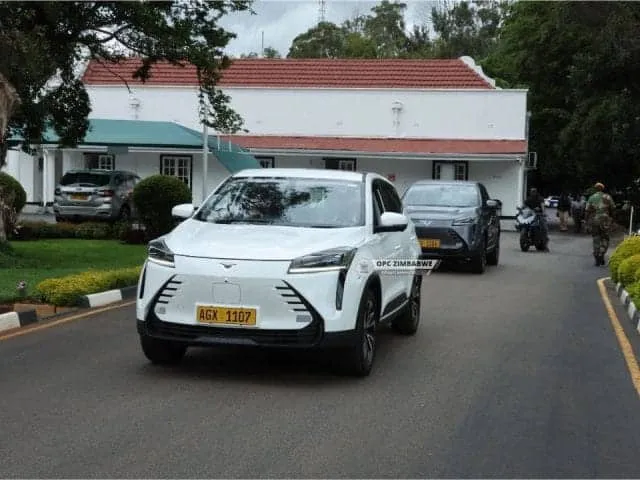Zim’s Maxwell Chikumbutso created the Saith FEV, an SUV claiming to run on radio waves. Explore the tech
By eKayNews Online News Channel – “Get to know from us”
Harare, Zimbabwe – Zimbabwean inventor and entrepreneur, Maxwell Sangulani Chikumbutso, has once again made headlines with his latest creation: the Saith FEV. This electric vehicle, he claims, requires no fuel, recharging, or external power source. It’s a self-sustaining machine, drawing its energy entirely from radio waves. This bold assertion has ignited both excitement and considerable skepticism.
Chikumbutso’s narrative revolves around the idea of capturing and converting the energy from radio waves, typically measured in minute nanovolts. He claims his device, largely composed of custom-made components, can amplify and utilize this energy to power vehicles
The Saith FEV is a self-powering electric vehicle (EV) that runs on radio waves. It was invented by Maxwell Chikumbutso, a Zimbabwean entrepreneur and inventor. The Saith FEV is designed to be a sustainable alternative to traditional electric vehicles.
-
No fuel, recharging, or external power
The Saith FEV is powered by radio waves and doesn’t require any fuel, recharging, or external power
-
Lightweight design
The Saith FEV is designed to be lightweight, which improves performance and reduces its environmental impact
-
Efficient energy conversion system
The Saith FEV’s energy conversion system is designed to be efficient
-
Multiple driving modes
The Saith FEV has multiple driving modes, including a sport mode for faster acceleration
- The Saith FEV could revolutionize the automotive industry and the way people think about energy consumption in vehicles
- The Saith FEV could also be used as a moving generator to power homes
The Presidential Showcase
Chikumbutso recently demonstrated his revolutionary powertrain to Zimbabwean President Emmerson Mnangagwa at State House in Harare. The presentation featured both a car and a motorcycle, both supposedly powered by Chikumbutso’s “Microsonic energy device.” He states that this device harnesses the ubiquitous radio frequencies surrounding us, converting them into usable energy. President Mnangagwa’s expected official launch of the car highlights the Zimbabwean government’s keen interest in this potentially game-changing technology.
A Call to Action: Investing in African Innovation
eKayNews urges the Zimbabwean government and African investors to rally behind Chikumbutso and Saith Technologies. This represents a critical opportunity to invest in African ingenuity and establish this potentially revolutionary technology on the continent. Such investment in research, development, and production would not only stimulate Zimbabwe’s economy but also position Africa as a leader in sustainable energy. Sharing Chikumbutso’s knowledge with higher learning institutions, including engineering and technology colleges and universities, is also essential for cultivating the next generation of African innovators.
The Technology: A Leap of Faith
Chikumbutso’s concept revolves around capturing and converting the energy from radio waves, measured in tiny nanovolts. He claims his device, built largely with custom-made components, can amplify and use this energy to power vehicles. However, the scientific community remains unconvinced. Radio waves do carry energy, but the amount is incredibly small. Current technology struggles to efficiently capture and convert this ambient radio frequency energy into usable power, especially at the scale needed for vehicles. The laws of thermodynamics present a major obstacle; the energy captured might be insufficient to overcome the energy needed for the conversion process itself, let alone propel a vehicle. This is a key point raised by experts, including those cited by publications like Car Magazine (www.carmag.co.za).
A History of Bold Claims
This is not the first time Chikumbutso and Saith Technologies (https://saithtechnologies.com/) have made such ambitious pronouncements. The company has previously touted electric vehicles that don’t require charging and energy generation systems powered by radio waves. These previous claims, however, lack independent verification, fueling skepticism about the current assertions.
The “Microsonic Energy Device”: A Mystery
The specific workings of Chikumbutso’s “Microsonic energy device” remain undisclosed. This lack of transparency further complicates the debate. Without detailed explanations, independent testing, and peer-reviewed studies, it’s impossible to validate his claims. Critics point to the absence of scientific rigor in his demonstrations, while his supporters emphasize his ingenuity and the potential for groundbreaking technology.
The Saith FEV: Future or Fantasy?
The Saith FEV, reportedly based on a modified Chery Tiggo 4 Pro platform, is presented as a fully electric vehicle powered entirely by radio waves. While the vehicle’s appearance is conventional, the powertrain is claimed to be revolutionary. If Chikumbutso’s claims prove accurate, the Saith FEV could indeed transform the automotive industry and how we think about energy. However, until verifiable data and rigorous scientific scrutiny are provided, the radio wave-powered car remains in the realm of speculation.
The Need for Verification and Transparency
The potential impact of Chikumbutso’s invention, if validated, is immense. A self-powered electric vehicle could revolutionize transportation, lessen our dependence on fossil fuels, and contribute to a more sustainable future. But rigorous scientific scrutiny is essential. Independent verification, peer review, and transparent disclosure of the technology are crucial to establish its credibility.
Investing in African Innovation
Despite the existing skepticism, Chikumbutso’s work underscores the importance of fostering innovation and supporting African inventors. The Zimbabwean government’s endorsement suggests a potential commitment to investing in domestic technology. African investors also have a vital role to play in backing promising ventures that could benefit the entire continent. Regardless of the Saith FEV’s ultimate outcome, the pursuit of innovative solutions to Africa’s challenges deserves our attention and support.
Thank you for reading. Please share this article to raise awareness about African innovation





